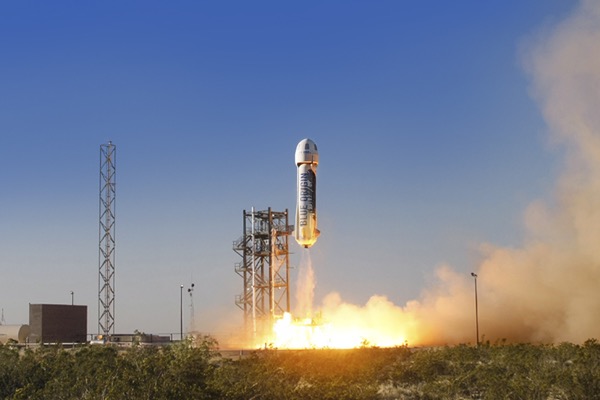Space, fighting for airspaceby Jeff Foust
|
| “I’ve heard a lot of, ‘well, we’re not new entrants.’ Well, actually, you are,” Bertapelle said. “You’re a new schedule entrant into the national airspace system, which is a national resource.” |
At a two-day meeting in Washington last month, jointly organized by the FAA and the Air Traffic Control Association (ATCA), representatives of the aviation industry frequently called out their space counterparts as, in essence, the new kids on the block, ones that needed to do a better job following rules and not disrupting the business of commercial aviation.
“Commercial space is one of the many new entrants that are knocking at the door, requiring access to the airspace,” said Peter Dumont, president and CEO of ATCA, in opening remarks at the event. He was the first of several speakers that frequently referred to commercial space as a “new entrant” in the field.
That phrase rubbed some in the industry, and even its regulators, the wrong way. “Let me say a little bit about the term ‘new entrant.’ It’s an interesting term that we use often to talk about commercial space and other things,” said Kelvin Coleman, acting administrator for commercial space transportation at the FAA, in remarks a short time later. “I think it’s a bit of a misnomer, given that we’ve been launching rockets commercially in this country for quite a while.”
The term “new entrant” as applied to space, he said, “really translates into the fact that the agency really sees, maybe for the first time, that commercial space is a significant player in the NAS, an activity that warrants more attention, more investment of our time and resources, and the services that we render.”
The meeting was intended to discuss ways for the aviation and space industries to work closer together in resolving airspace access issues. But the use of the term “new entrant” wasn’t the only sign that the two groups have a lot of work to do.
One panel on the conference’s second day features discussion about Collaborative Decision Making (CDM), the aviation industry’s tool for sharing data about their flight plans and coordinating any issues that result from it.
It was time, one speaker said, for the space industry to get involved with CDM. “To the spaceports, the rocket launchers, all you guys, welcome to CDM,” said Joe Bertapelle, director of strategic airspace programs at JetBlue Airways. “That’s not a question. You’re in. You can’t get out.”
“I’ve heard a lot of, ‘well, we’re not new entrants.’ Well, actually, you are,” he continued. “You’re a new schedule entrant into the national airspace system, which is a national resource. We all share it. You’re running a schedule, but so is everybody up here.”
Bertapelle took issue with the long airspace closures for launches, in particular the inaugural launch of the Falcon Heavy from Florida in February that disrupted airline traffic on key East Coast corridors for several hours. Space industry officials had played down the impact that flight had: at the International Symposium for Personal and Commercial Spaceflight in New Mexico last month, Eric Stallmer, president of the Commercial Spaceflight Federation (CSF), said that about 515 flights were forced to reroute because of that launch, with an average delay of eight minutes.
Bertapelle offered a different opinion. “Why I will go back and say, ‘Welcome to CDM, rocketeers,’ is because of Elon Musk,” he said. “That day when he shut down the East Coast for eight hours, just waiting for a rocket to go up, might have been a great publicity stunt, but it was a dramatic failure of managing the national airspace system that day.”
“I’m going to be blunt with you: American [Airlines] misconnected their entire evening northbound flow into Miami. People spent nights in the hotels. It cost us an enormous amount of money. For what?” he said.
| “Why I will go back and say, ‘Welcome to CDM, rocketeers,’ is because of Elon Musk,” Bertapelle said. “That day when he shut down the East Coast for eight hours, just waiting for a rocket to go up, might have been a great publicity stunt, but it was a dramatic failure of managing the national airspace system.” |
He said the space industry had to do a better job sticking to schedules and limiting the amount of airspace it blocked off. “We need your accurate departure time, when the rocket goes up,” he said. “That two-hour block window, we have to shorten by a lot. Not by half: let’s get it down to 20 minutes. You have a launch window of 20 minutes, execute to it. You get annoyed at us airlines for not leaving on time; execute to your schedule.”
The space industry largely agrees with the desire to both shrink the size and shorten the duration of airspace closures. They’re not necessarily in agreement, though, about how to do so. “We’ve heard a lot about CDM, and it’s sometimes spoken about in reverent tones as this holy system of allocating airspace, and we get that,” said Jim Muncy, representing CSF on the panel. The space industry, he said, supported the idea of exchanging data, but not necessarily through CDM. “We think we’re interested in it, we are open to learning more about it, but we’re not rushing headlong into a process and then finding out about how a process works once we get there.”
The concern the industry has, he said, is a mismatch in the types of vehicles and the frequency of operations. “We get that we have a major impact on airline operations, and we want to minimize that,” he said. “We absolutely want to share information with the airline industry. We would like to share information with the airline industry today.”
The problem, he said, is that launches today are still infrequent: one or two a month. “The pace is just different,” he said, compared to the CDM, which holds telecons every two hours throughout each day for updates on events affecting airspace operations. “What’s important to us may be more strategic information in terms of how the CDM works to help shape policy, make investment decisions about improving the NAS, and things like that.”
 New Shepard lifts off from Blue Origin’s West Texas test site on its first test flight in April 2015. (credit: Blue Origin) |
Empty land, busy airspace
While Bertapelle was concerned—agitated, even—about the spaceflight industry’s impact on airspace because of launches from Florida, it’s not the only place in the country where launch vehicles and commercial aviation run into conflict. Blue Origin performs test flights of its New Shepard suborbital vehicle at a remote site in West Texas, many kilometers away from the nearest town.
But, while the terrain around the site is empty, the skies above it are not. “West Texas looks very much like the middle of nowhere, but you’ve got the LA corridors going through there from Houston, Miami, and Dallas,” said Audrey Powers, deputy general counsel at Blue Origin, during another panel at the conference.
Blue Origin gets airspace closures for its launches from the FAA (for the early phases of its test program, those notices were often the only advance warning of an impending test flight.) The company works with the FAA regional air traffic control center in Albuquerque, New Mexico, regarding when to close the airspace and for how long.
| “West Texas looks very much like the middle of nowhere, but you’ve got the LA corridors going through there from Houston, Miami, and Dallas,” said Blue Origin’s Powers of their New Shepard launch site. |
That’s not been without problems. “We’ve now flown New Shepard nine times, and for the first seven flights of New Shepard, we had airspace issues,” she said. “Our architecture was somewhat unfamiliar to the air traffic center we were dealing with, and Blue Origin was launching from a private launch site” rather than a range run by a government organization.
The process has improved over time, though, she noted, including limiting the amount of time the airspace was closed. Initially the airspace was closed for six hours at a time, but the company worked with the FAA to improve communications so as to narrow those windows. “We went from an hours-long closure to the second and third flights, where we narrowed that down to 45 minutes,” she said.
Airspace can also be an issue for Pacific Spaceport Complex-Alaska, the spaceport on Kodiak Island operated by Alaska Aerospace Corporation. That launch site, which long saw little activity, has seen renewed interest from small launch vehicle operators, including Astra Space, a secretive company that has performed at least one suborbital flight from the facility; and Vector, which plans to perform its first orbital launch there in the coming months.
“It’s been fun, but I’m going to tell you it’s a challenge” coordinating airspace, said Craig Campbell, president and CEO of Alaska Aerospace, on the same panel as Powers. Kodiak is also an isolated site, but the airspace over Alaska is filled with traffic on trans-Pacific routes between North America and Asia.
“We’ve closed airspace for hours at a time, day after day, with no launch, requiring carriers to have to be rerouted when there was no event that occurred,” he said. “That’s problematic. It’s problematic for the airline industry, it’s problematic for our economy, but it doesn’t make for a nimble spaceport, either.”
Campbell supported the use of more realtime data about the status of the launch, enabling the airspace to be closed only when a launch was taking place rather than a fixed window during which a launch may—or may not—occur.
The space industry in general has been open to such processes. It has been working with the FAA on technologies like the Space Data Integrator, which allows air traffic controllers access to realtime launch data, enabling airspace to be closed and reopened more dynamically.
Candy to a knife fight
There’s also been more communication between the space and aviation industries about their operations and processes. The FAA established a committee called the Airspace Access Priorities Aviation Rulemaking Committee (ARC) that included representatives from both the aviation and space industries to discuss the use and coordination of airspace for their industries.
| “This was my first experience with an ARC,” said the CSF’s Stallmer, the other co-chair, “and I felt like I brought candy to a knife fight when I first got there.” |
“We really don’t know a lot about each others’ industries,” said Mike Cirillo, managing director for air traffic management at Airlines For America, the airline industry trade group, and one of the co-chairs of the committee. Committee members spent a lot of time educating each other on how their industries operate, which included visits to a Delta Airlines operations center and to Cape Canaveral.
To the space industry, that process was a little intimidating. “This was my first experience with an ARC,” said the CSF’s Stallmer, the other co-chair, “and I felt like I brought candy to a knife fight when I first got there.”
The ARC, though, has helped the aviation industry understand spaceflight and the space industry understand aviation. “We kind of coalesced together and got a better understanding of what each other is doing,” he said. “Remarkably, now we’re all working together.”
“I learned how much I don’t know,” Cirillo said, recalling the group’s trip to the Cape. “I definitely walked away from there humbled, and realizing there is so much more that our industries need to learn from each other.”
That dialogue, they said, might be more valuable than any rulemaking that comes out of the committee. “I think this ARC has planted the seeds” for future collaboration on airspace issues, Stallmer said, such as on relevant legislation.
Those discussions and mutual understanding, at the very least, are an improvement on assessing blame.
Note: we are temporarily moderating all comments subcommitted to deal with a surge in spam.
